QT210 开发板 LED应用程序
目的: 编写一个android应用程序来控制开发板上led灯的亮与灭.
编译环境: Ubuntu12.04
Android系统: android4.0 (linux3.0.8)
一.驱动
1. 查看原理图,QT210开发板上led D5, D6, D7, D8 对应引脚为EINT0, EINT1, EINT2, EINT3.
Tigerboard-II底板.pdf
2. 根据底板上的EINT引脚,在核心板上找到与之相对应的引脚,最终对应到了GPIO的GPH0_0, GPH0_1, GPH0_2, GPH0_3
QT210V2核心板.pdf:
3. 接下来在三星 S5PV210芯片手册上找到相应寄存器.控制led灯实际就是控制相应寄存器.
S5PV210_EVT1_Usermanual_20100218.pdf
4. 编写驱动文件led.c
#include <linux/module.h>
#include <linux/kernel.h>
//#include <linux/io.h>
#include <asm/irq.h>
#include <asm/io.h>
#include <linux/fs.h>
#include <asm/uaccess.h>
#include <linux/miscdevice.h>
#include <linux/pci.h>
#include <linux/ioctl.h>
#include <linux/init.h>
#include <linux/delay.h>
#define DEVICE_NAME "leds" //设备名(/dev/leds)
#define LED_MAJOR 240
unsigned long *gph0con = NULL;
unsigned long *gph0dat = NULL;
int major;
static int led_ioctl(struct file *file, unsigned int cmd, unsigned long arg)
{
printk(KERN_ALERT"\ncmd = %d arg = %d \n", cmd, arg);
switch(cmd)
{
case 0:
printk(KERN_ALERT"led%d off\n", arg);
switch(arg)
{
case 0:
*gph0dat &= ~0x01;
break;
case 1:
*gph0dat &= ~0x02;
break;
case 2:
*gph0dat &= ~0x04;
break;
case 3:
*gph0dat &= ~0x08;
break;
default:
break;
}
break;
case 1:
printk(KERN_ALERT"led%d on\n", arg);
switch(arg)
{
case 0:
*gph0dat |= 0x01;
break;
case 1:
*gph0dat |= 0x02;
break;
case 2:
*gph0dat |= 0x04;
break;
case 3:
*gph0dat |= 0x08;
break;
default:
break;
}
break;
case 11:
printk(KERN_ALERT"led all on\n");
*gph0dat |= 0xf;
break;
case 10:
printk(KERN_ALERT"led all off\n");
*gph0dat &= ~0xf;
break;
default:
break;
}
return 0;
}
struct file_operations led_fops={
.owner = THIS_MODULE,
.unlocked_ioctl = led_ioctl,
};
static struct miscdevice misc = {
.minor = MISC_DYNAMIC_MINOR, //动态设备号
.name = DEVICE_NAME,
.fops = &led_fops,
};
static int __init led_init(void)
{
int rc;
gph0con = (unsigned long *)ioremap(0xE0200C00, 16);
gph0dat = (unsigned long *)ioremap(0xE0200C04, 8);
*gph0con &= ~0xffff;
*gph0con |= 0x1111;
*gph0dat &= ~0xf;
rc = misc_register(&misc);
if(rc<0)
{
printk(KERN_ALERT"register %s char dev error\n","leds");
return -1;
}
else
printk(KERN_ALERT" lcd module OK!\n");
return 0;
}
static void __exit led_exit(void)
{
unregister_chrdev(LED_MAJOR, "leds");
printk(KERN_ALERT"module exit\n");
}
module_init(led_init);
module_exit(led_exit);
MODULE_LICENSE("GPL");
MODULE_AUTHOR("cw");
5. 编写led.c的Makefile. 这里将led驱动编译成模块的方式.
注意: 编写Makefile时,行的开头只能用Tab,不能用空格.
KERNELDIR :=/home/share/210/android4.0/4.0/qt210_ics_kernel3.0.8
PWD :=$(shell pwd)
modules:
$(MAKE) -C $(KERNELDIR) M=$(PWD) modules
modules_install:
$(MAKE) -C $(KERNELDIR) M=$(PWD) modules_install
obj-m:=led.o
clean:
rm -rf *.o *~core .depend .*.cmd *.ko *.mod.c .tmp_versions *.order *.symvers
6. 编译
编译成功后生成led.ko模块.
7. 将led.ko 拷贝到开发板上,半加载.加载之后会在/dev/目录下生成leds这个设备.
二. Android应用程序
1. 新建一个Android应用程序
2. 打开 src/LedActivity.java,
添加public static native int led_ioctl(int i, int j);
添加一个接口是为了利用java来生成jni的头文件.
src/LedActivity.java:
package com.example.led;
import android.os.Bundle;
import android.app.Activity;
import android.view.Menu;
public class LedActivity extends Activity {
@Override
protected void onCreate(Bundle savedInstanceState) {
super.onCreate(savedInstanceState);
setContentView(R.layout.activity_led);
}
@Override
public boolean onCreateOptionsMenu(Menu menu) {
// Inflate the menu; this adds items to the action bar if it is present.
getMenuInflater().inflate(R.menu.led, menu);
return true;
}
public static native int led_ioctl(int i, int j);
}
3. 编译整个android项目,将整个Led项目文件拷贝到ubuntu上.
新建一个jni目录
4. 利用java文件自动生成jni头文件.
javah -classpath bin/classes -d jni com.example.led.LedActivity
5. jni目录下编写led.c 即led测试程序led.c.
Led/jni/led.c:
#include <jni.h>
#include <stdio.h>
#include <stdlib.h>
#include <fcntl.h>
#include <unistd.h>
#include <sys/ioctl.h>
#include <android/log.h>
#define LOG_TAG "LED" //android logcat
#define LOGI(...) __android_log_print(ANDROID_LOG_INFO,LOG_TAG,__VA_ARGS__ )
#define LOGE(...) __android_log_print(ANDROID_LOG_ERROR,LOG_TAG,__VA_ARGS_ _)
//int main(int argc, char **argv)
jint JNICALL Java_com_example_led_LedActivity_led_1ioctl(JNIEnv *env, jclass thiz, jint led_nu, jint on)
{
int fd;
fd = open("/dev/leds", O_RDWR);
if(fd < 0)
printf("Can't open /dev/leds!\n");
ioctl(fd, on, led_nu);
LOGI("led_nu=%d,state=%d\n", led_nu, on);
close(fd);
return 0;
}
6. jni目录下编写Android.mk
Led/jni/Android.mk
LOCAL_PATH := $(call my-dir)
include $(CLEAR_VARS)
LOCAL_MODULE := Led_ctrl
LOCAL_SRC_FILES := led.c
LOCAL_LDLIBS := -llog
LOCAL_C_INCLUDES := $(MY_ANDROID_SOURCE)/frameworks/base/core/jni/android/graphics \
$(MY_ANDROID_SOURCE)/external/skia/include/core \
$(MY_ANDROID_SOURCE)/external/skia/include/images \
$(MY_ANDROID_SOURCE)/frameworks/base/include \
$(MY_ANDROID_SOURCE)/system/core/include
include $(BUILD_SHARED_LIBRARY)
7. Led目录下运行ndk-bluild, 将led.c文件编译成so库文件.
前提是你已经安装了android-ndk 工具(http://blog.csdn.net/colwer/article/details/8944166)
8. 将生成的libLed_ctrl.so拷贝到eclipse下Led应用程序中的libs/armeabi目录(如果没有armeabi目录需手动创建一个)
9. 在应用程序布局文件中加入4个开关按钮,对应四个led开关,也可以再添加一个总开关来同时控制四个led.
res/layout/activity_led.xml
<LinearLayout xmlns:android="http://schemas.android.com/apk/res/android"
xmlns:tools="http://schemas.android.com/tools"
android:orientation="vertical"
android:layout_width="match_parent"
android:layout_height="match_parent"
android:paddingBottom="@dimen/activity_vertical_margin"
android:paddingLeft="@dimen/activity_horizontal_margin"
android:paddingRight="@dimen/activity_horizontal_margin"
android:paddingTop="@dimen/activity_vertical_margin"
tools:context=".LedActivity" >
<ToggleButton
android:id="@+id/btn1"
android:layout_width="140dip"
android:layout_height="wrap_content"
android:textOn="led1 on"
android:textOff="led1 off"
android:layout_gravity="center_horizontal"
/>
<ToggleButton
android:id="@+id/btn2"
android:layout_width="140dip"
android:layout_height="wrap_content"
android:textOn="led2 on"
android:textOff="led2 off"
android:layout_gravity="center_horizontal"
/>
<ToggleButton
android:id="@+id/btn3"
android:layout_width="140dip"
android:layout_height="wrap_content"
android:textOn="led3 on"
android:textOff="led3 off"
android:layout_gravity="center_horizontal"
/>
<ToggleButton
android:id="@+id/btn4"
android:layout_width="140dip"
android:layout_height="wrap_content"
android:textOn="led4 on"
android:textOff="led4 off"
android:layout_gravity="center_horizontal"
/>
</LinearLayout>10. 编写 java 文件 .
src/LedActivity.java:
package com.example.led;
import android.os.Bundle;
import android.app.Activity;
import android.util.Log;
import android.view.Menu;
import android.view.View;
import android.widget.Button;
import android.widget.ToggleButton;
public class LedActivity extends Activity {
private static final String TAG = "LED";
private ToggleButton button1;
private ToggleButton button2;
private ToggleButton button3;
private ToggleButton button4;
@Override
protected void onCreate(Bundle savedInstanceState) {
super.onCreate(savedInstanceState);
setContentView(R.layout.activity_led);
button1 = (ToggleButton)findViewById(R.id.btn1);
button2 = (ToggleButton)findViewById(R.id.btn2);
button3 = (ToggleButton)findViewById(R.id.btn3);
button4 = (ToggleButton)findViewById(R.id.btn4);
button1.setOnClickListener(new Button.OnClickListener()
{
public void onClick(View v)
{
if (button1.isChecked())
led_ioctl(0, 1); //led1 on
else
led_ioctl(0, 0); //led1 off
}
});
button2.setOnClickListener(new Button.OnClickListener()
{
public void onClick(View v)
{
if (button2.isChecked())
led_ioctl(1, 1); //led2 on
else
led_ioctl(1, 0); //led2 off
}
});
button3.setOnClickListener(new Button.OnClickListener()
{
public void onClick(View v)
{
if (button3.isChecked())
led_ioctl(2, 1); //led3 on
else
led_ioctl(2, 0); //led3 off
}
});
button4.setOnClickListener(new Button.OnClickListener()
{
public void onClick(View v)
{
if (button4.isChecked())
led_ioctl(3, 1); //led4 on
else
led_ioctl(3, 0); //led4 off
}
});
}
@Override
public boolean onCreateOptionsMenu(Menu menu) {
// Inflate the menu; this adds items to the action bar if it is present.
getMenuInflater().inflate(R.menu.led, menu);
return true;
}
public static native int led_ioctl(int i, int j);
static
{
System.loadLibrary("Led_ctrl"); // libs/armeabi/libLed_ctrl.so
}
}
编译生成Led.apk,并安装到开发板上.
至此,整个工作已经完成,开发板上打开应用程序就可以控制led了.但有几点需要注意
1. 开发板上D5这个灯已经被占用了,所以led1不能控制D5了.
2. 记住运行应用程序前确保内核中led.ko已被加载,并修改 /dev/leds的权限,否则led灯不受控制.
整个代码已打包上传到我的博客:
http://download.csdn.net/detail/colwer/5403281
本人新手,欢迎大家帮忙指正错误和提供建议.
下一步计划做一个远程控制的.就是局域网内通过另一个android设备来操控开发板.










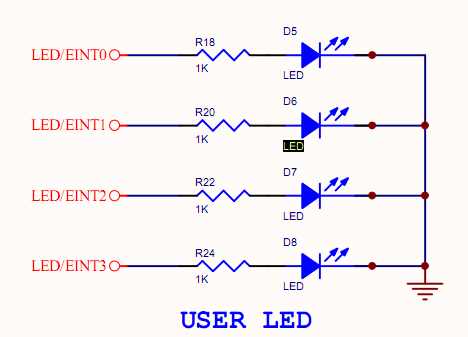


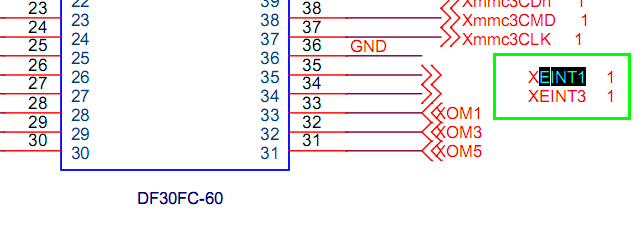

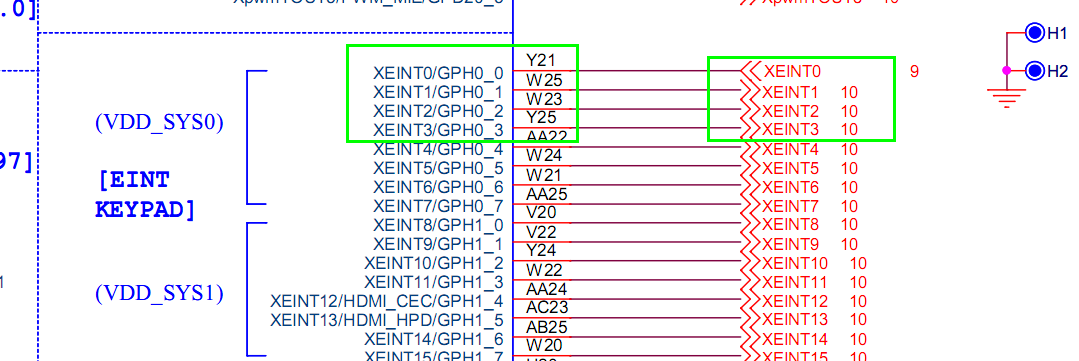
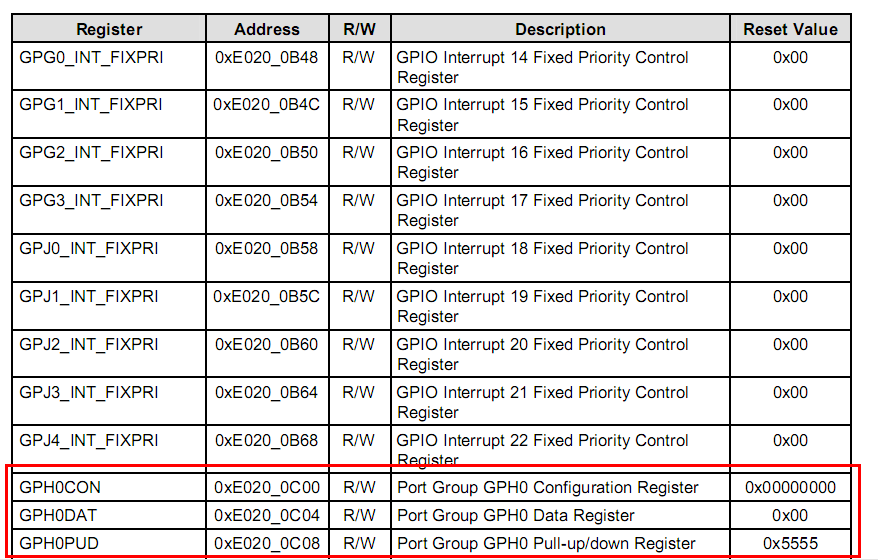


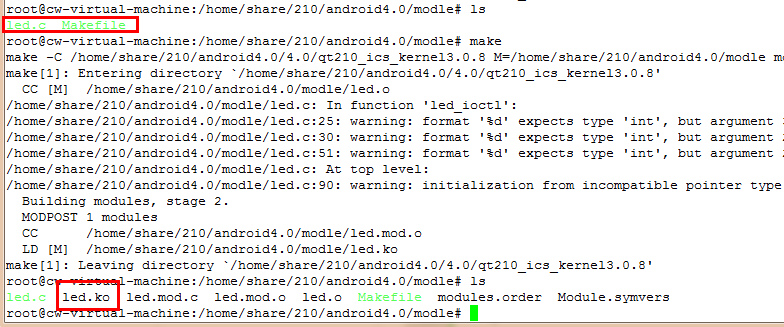
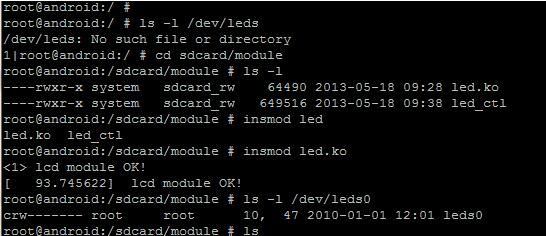
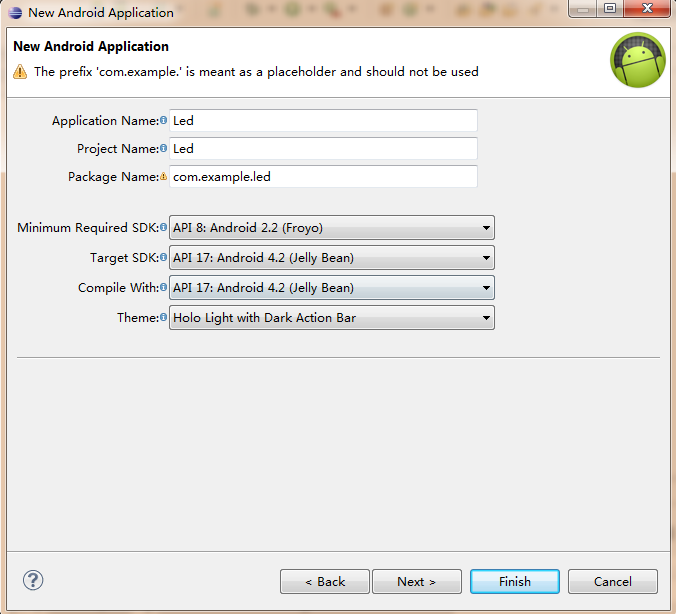
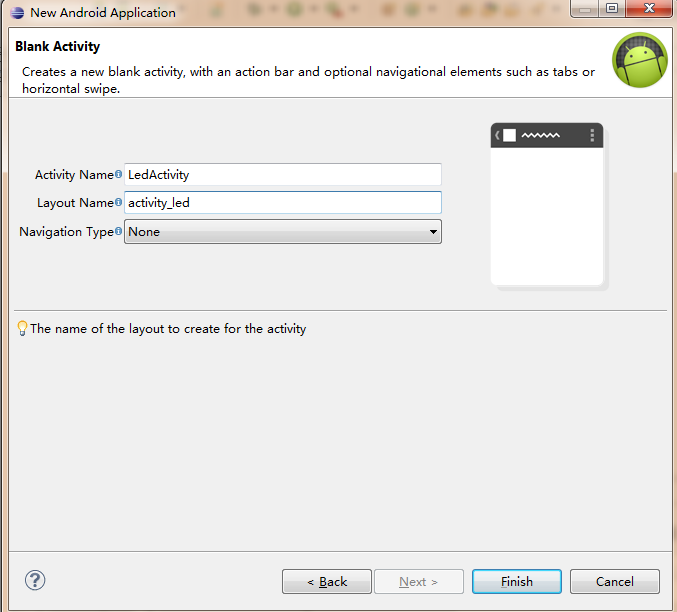





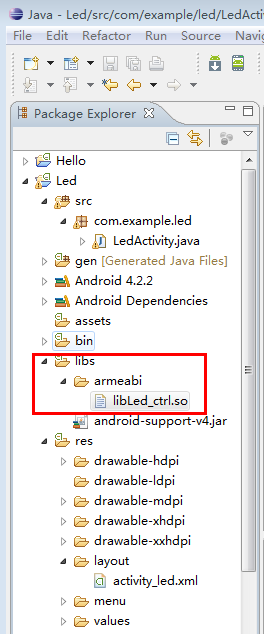














 1201
1201

 被折叠的 条评论
为什么被折叠?
被折叠的 条评论
为什么被折叠?








